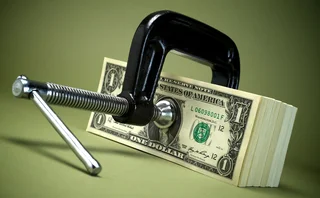
Shhh, don’t tell: the struggle to keep skew under wraps
Liquidity recycling by clients has made it more difficult for banks to keep skews quiet
The ‘six degrees of separation’ theory posits that people are never more than six social connections away from each other – even if they are complete strangers and move in very different circles. The theory has been popularised via the game Six Degrees of Kevin Bacon, in which players are challenged to connect any given actor to the eponymous movie star in six steps or less.
Similar daisy-chain relationships exist in foreign exchange markets – but it can be a costly game to play.
When a dealer is axed to trade a particular side of a currency, it may skew its pricing – that is, move either the bid or the offer closer to the market’s mid – to make it more appealing. This information is potentially valuable to other market participants, allowing them to infer the dealer’s position and trading intent, and some algorithms are designed specifically to exploit it. This has led to the development of ‘skew safe’ pools where banks can offload risk on trading platforms with trusted counterparties.
But the problem persists. In recent years, large liquidity providers (LPs) have set up direct streaming relationships with smaller dealers that can pass along the original pricing to their end-clients. If the original LP offers a skewed priced to a regional bank or a prime-of-prime broker client, with the client then recycling it to its own customer, the skew information can still be broadcast to the wider market.
Another issue is when a counterparty to the original skewing LP uses this pricing as a market data source for its own execution algorithms. The original LP loses control of the information.
Trying to keep skewed prices quiet is like trying to lose the Six Degrees of Kevin Bacon game. You don’t want to be connected back to the prolific actor; you don’t want to be drawn into a network where connections proliferate and you are just a step or two away from hungry, skew-sniffing sharks. So, banks have developed sophisticated tools to try and avoid leaky market nodes – clients that are transmitting information about the bank’s positions to the rest of the market.
Some have even assigned ‘skew leakage’ scores to certain clients to determine how often they can skew a price to them. If the client has a bad score and fails to make improvements, then the LP can decide to stop offering better prices.
However, detecting information leakage is incredibly difficult and the signals used to distinguish where, when and how skewed prices are being leaked are fairly weak. Banks also don’t want to be scared away from showing better prices to their clients because that would ultimately translate into lost business.
It’s possible to imagine a solution to all of this – an industry-wide effort that would knit together LPs, their clients, and trading platforms to ensure skewed prices are seen only by the intended recipient. Possible, but extraordinarily difficult. Until the day arrives when banks feel footloose and free to skew, they will continue playing the Six Degrees game, and hoping that their price and position information can be contained.
Only users who have a paid subscription or are part of a corporate subscription are able to print or copy content.
To access these options, along with all other subscription benefits, please contact info@fx-markets.com or view our subscription options here: https://subscriptions.fx-markets.com
You are currently unable to print this content. Please contact info@fx-markets.com to find out more.
You are currently unable to copy this content. Please contact info@fx-markets.com to find out more.
Copyright Infopro Digital Limited. All rights reserved.
As outlined in our terms and conditions, https://www.infopro-digital.com/terms-and-conditions/subscriptions/ (point 2.4), printing is limited to a single copy.
If you would like to purchase additional rights please email info@fx-markets.com
Copyright Infopro Digital Limited. All rights reserved.
You may share this content using our article tools. As outlined in our terms and conditions, https://www.infopro-digital.com/terms-and-conditions/subscriptions/ (clause 2.4), an Authorised User may only make one copy of the materials for their own personal use. You must also comply with the restrictions in clause 2.5.
If you would like to purchase additional rights please email info@fx-markets.com
More on Trading
Review of 2025: A topsy-turvy ride
Rollercoaster year for FX traders ends with G10 volatility and hedging flows back where they started
US insurers turn to short-dated FX forwards as notionals rise
Counterparty Radar: Trades under three months make up nearly 60% of total positions, up from just a third in 2022
October’s crash shows crypto has come of age
Ability to absorb $19bn liquidation event marks a turning point in market’s maturity, says LMAX Group's Jenna Wright
Dealers warn of capital squeeze from increased FX hedging
Sharp rise in uncollateralised buy-side hedges could restrict banks’ ability to take on positions
Quants tell FX dealers how to make the most of passive liquidity
Paper from HSBC and Imperial sets out when to skew pricing, and when not
Dealer views mixed over future of profitable EM FX carry trade
Emerging market FX carry trades have generated 7.5% returns since April, but dealers question longevity
BIS points to ‘structural transformations’ in markets
Quarterly review cites higher volatility and gold losing its status as a safe haven asset
Banks scale back short-dated FX swaps trading, BIS finds
Interbank FX swaps hit by higher short-term hedging and funding costs, while longer-dated forwards activity jumps








